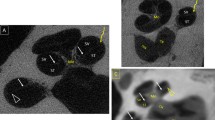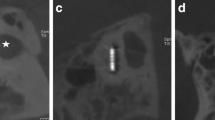Abstract
The aim of this study was to evaluate the insertion results and placement of the new Advanced Bionics HiFocus Mid-Scala (HFms) electrode array, inserted through the round window membrane, in eight fresh human temporal bones using cone beam computed tomography (CBCT). Pre- and post-insertion CBCT scans were registered to create a 3D reconstruction of the cochlea with the array inserted. With an image fusion technique both the bony edges of the cochlea and the electrode array in situ could accurately be determined, thus enabling to identify the exact position of the electrode array within the scala tympani. Vertical and horizontal scalar location was measured at four points along the cochlea base at an angular insertion depth of 90°, 180° and 270° and at electrode 16, the most basal electrode. Smooth insertion through the round window membrane was possible in all temporal bones. The imaging results showed that there were no dislocations from the scala tympani into the scala vestibule. The HFms electrode was positioned in the middle of the scala along the whole electrode array in three out of the eight bones and in 62 % of the individual locations measured along the base of the cochlea. In only one cochlea a close proximity of the electrode with the basilar membrane was observed, indicating possible contact with the basilar membrane. The results and assessments presented in this study appear to be highly accurate. Although a further validation including histopathology is needed, the image fusion technique described in this study represents currently the most accurate method for intracochlear electrode assessment obtainable with CBCT.






Similar content being viewed by others
References
Aschendorff A, Kromeier J, Klenzner T, Laszig R (2007) Quality control after insertion of the nucleus contour and contour advance electrode in adults. Ear Hear 28(2 Suppl):75S–79S
Finley CC, Holden TA, Holden LK et al (2008) Role of electrode placement as a contributor to variability in cochlear implant outcomes. Otol Neurotol 29:920–928
Carlson ML, Driscoll CL, Gifford RH, Servic GJ, Tombers NM, Hughes-Borst BJ, Neff BA, Beatty CW (2011) Implications of minimizing trauma during conventional cochlear implantation. Otol Neurotol 32(6):962–968
Ramsden JD, Gordon K, Aschendorff A, Borucki L, Bunne M, Burdo S, Garabedian N, Grolman W, Irving R, Lesinski-Schiedat A, Loundon N, Manrique M, Martin J, Raine C, Wouters J, Papsin BC (2012) European bilateral pediatric cochlear implant forum consensus statement. Otol Neurotol 33(4):561–565
Briggs RJ, Tykocinski M, Saunders E, Hellier W, Dahm M, Pyman B, Clark GM (2001) Surgical implications of perimodiolar cochlear implant electrode design: avoiding intracochlear damage and scala vestibuli insertion. Cochlear Implants Int 2(2):135–149
Adunka O, Kiefer J, Unkelbach MH, Lehnert T, Gstoettner W (2004) Development and evaluation of an improved cochlear implant electrode design for electric acoustic stimulation. Laryngoscope 114(7):1237–1241
Skarzynski H, Lorens A, Matusiak M, Porowski M, Skarzynski PH, James CJ (2012) Partial deafness treatment with the nucleus straight research array cochlear implant. Audiol Neurootol 17(2):82–91
Gstoettner WK, Adunka O, Franz P, Hamzavi J Jr, Plenk H Jr, Susani M, Baumgartner W, Kiefer J (2001) Perimodiolar electrodes in cochlear implant surgery. Acta Otolaryngol 121:216–219
Gantz BJ, Dunn C, Oleson J, Hansen M, Parkinson A, Turner C (2016) Multicenter clinical trial of the nucleus hybrid S8 cochlear implant: final outcomes. Laryngoscope. (Epub ahead of print)
Helbig S, Settevendemie C, Mack M, Baumann U, Helbig M, Stöver T (2011) Evaluation of an electrode prototype for atraumatic cochlear implantation in hearing preservation candidates: preliminary results from a temporal bone study. Otol Neurotol 32(3):419–423
Hassepass F, Bulla S, Maier W, Laszig R, Arndt S, Beck R, Traser L, Aschendorff A (2014) The new Mid-Scala electrode array: a radiologic and histologic study in human temporal bones. Otol Neurotol 35(8):1415–1420
Frisch CD, Carlson ML, Lane JI, Driscoll CL (2015) Evaluation of a new Mid-Scala cochlear implant electrode using microcomputed tomography. Laryngoscope 125(12):2778–2783
Dietz A, Wennström M, Lehtimäki A, Löppönen H, Valtonen H (2015) Electrode migration after cochlear implant surgery: more common than expected? Eur Arch Otorhinolaryngol. (Epub ahead of print)
Xu J, Xu SA, Cohen LT, Clark GM (2000) Cochlear view: postoperative radiography for cochlear implantation. Am J Otol 21(1):49–56
Cushing SL, Daly MJ, Treaba CG, Chan H, Irish JC, Blaser S, Gordon KA, Papsin BC (2012) High-resolution cone-beam computed tomography: a potential tool to improve atraumatic electrode design and position. Acta Otolaryngol 132(4):361–368
Saeed SR, Selvadurai D, Beale T, Biggs N, Murray B, Gibson P, Risi F, Boyd P (2014) The use of cone-beam computed tomography to determine cochlear implant electrode position in human temporal bones. Otol Neurotol 35(8):1338–1344
Marx M, Risi F, Escudé B, Durmo I, James C, Lauwers F, Deguine O, Fraysse B (2014) Reliability of cone beam computed tomography in scalar localization of the electrode array: a radio histological study. Eur Arch Otorhinolaryngol 271(4):673–679
Güldner C, Wiegand S, Weiss R, Bien S, Sesterhenn A, Teymoortash A, Diogo I (2012) Artifacts of the electrode in cochlea implantation and limits in analysis of deep insertion in cone beam tomography (CBT). Eur Arch Otorhinolaryngol 269(3):767–772
Ruivo J, Mermuys K, Bacher K, Kuhweide R, Offeciers E, Casselman JW (2009) Cone beam computed tomography, a low-dose imaging technique in the postoperative assessment of cochlear implantation. Otol Neurotol 30(3):299–303
Theunisse HJ, Joemai RM, Maal TJ, Geleijns J, Mylanus EA, Verbist BM (2015) Cone-beam CT versus multi-slice CT systems for postoperative imaging of cochlear implantation—a phantom study on image quality and radiation exposure using human temporal bones. Otol Neurotol 36(4):592–599
Majdani O et al (2009) Temporal bone imaging: comparison of flat panel volume CT and multisection CT. Am J Neuroradiol 30:1419–1424
Husstedt HW, Aschendorff A, Richter B, Laszig R, Schumacher M (2002) Nondestructive three-dimensional analysis of electrode to modiolus proximity. Otol Neurotol 23(1):49–52
Stutzki M, Jahns E, Mandapathil MM, Diogo I, Werner JA, Güldner C (2015) Indications of cone beam CT in head and neck imaging. Acta Otolaryngol 135(12):1337–1343
Dees G, van Hoof M, Stokroos R (2016) A proposed method for accurate 3D analysis of cochlear implant migration using fusion of cone beam CT. Front Surg 3:2. doi:10.3389/fsurg.2016.00002
Pieper S, Lorensen B, Schroeder W, Kikinis R (2006) The NA-MIC kit: ITK, VTK, pipelines, grids and 3D slicer as an open platform for the medical image computing community. In: 3rd IEEE international symposium on biomedical imaging: macro to nano, pp 698–701
Pieper S, Halle M, Kikinis R (2004) 3D slicer. In: 2nd IEEE international symposium on biomedical imaging: macro to nano (IEEE Cat No. 04EX821), vol 2, pp 632–635
Johnson H, Harris G (2007) BRAINSFit: mutual information registrations of whole-brain 3D images, using the insight toolkit. Insight J
Kurzweg T, Dalchow CV, Bremke M, Majdani O, Kureck I, Knecht R, Werner JA, Teymoortash A (2010) The value of digital volume tomography in assessing the position of cochlear implant arrays in temporal bone specimens. Ear Hear 31(3):413–419
Postnov A, Zarowski A, De Clerck N, Vanpoucke F, Offeciers FE, Van Dyck D, Peeters S (2006) High resolution micro-CT scanning as an innovative tool for evaluation of the surgical positioning of cochlear implant electrodes. Acta Otolaryngol 126(5):467–474
Faccioli N, Barillari M, Guariglia S, Zivelonghi E, Rizzotti A, Cerini R, Mucelli RP (2009) Radiation dose saving through the use of cone-beam CT in hearing-impaired patients. Radiol Med 114(8):1308–1318
Acknowledgments
The authors would like to thank Guido Dees, Marc van Hoof and Robert Stokroos from the Maastricht University Medical Centre (MUMC) in the Netherlands for the exchange of expertise on the image fusion and concepts of image processing used in this research.
Author information
Authors and Affiliations
Corresponding author
Ethics declarations
Conflict of interest
Author Dzemal Gazibegovic is an employee of Advanced Bionics’ AG clinical research department. The other authors declare that they have no conflict of interest.
Ethical standards
All procedures performed in this study involving human material were in accordance with the ethical standards of the institutional research committee and with the 1964 Helsinki declaration and its later amendments or comparable ethical standards.
Rights and permissions
About this article
Cite this article
Dietz, A., Gazibegovic, D., Tervaniemi, J. et al. Insertion characteristics and placement of the Mid-Scala electrode array in human temporal bones using detailed cone beam computed tomography. Eur Arch Otorhinolaryngol 273, 4135–4143 (2016). https://doi.org/10.1007/s00405-016-4099-x
Received:
Accepted:
Published:
Issue Date:
DOI: https://doi.org/10.1007/s00405-016-4099-x




